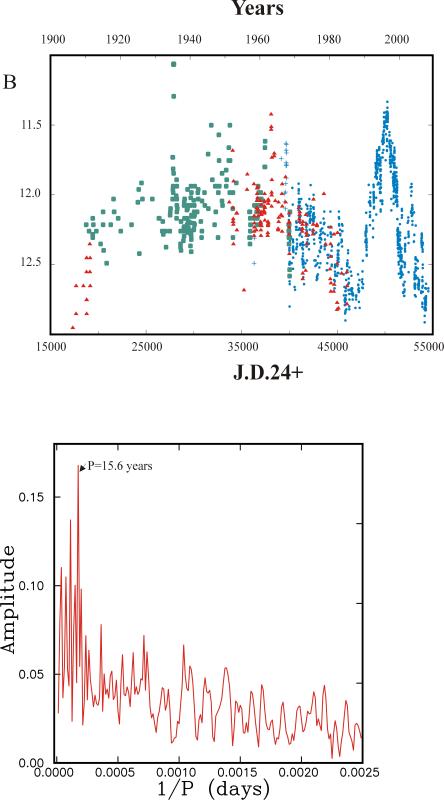"Peremennye Zvezdy",
Prilozhenie,
vol. 7, N 28 (2007)
Prilozhenie,
vol. 7, N 28 (2007)
Optical Variability of NGC 4151 During 100 Years
V. Oknyanskij, V. Lyuty
Russia, Moscow, SAI
Received: 2.11.2007; accepted: 13.11.2007
(E-mail for contact: oknyan@mail.ru)
| ||||||||||||||||||||||
Remarks: |
| We present the historical light curve of NGC 4151
for 1906 - 2007. The light curve is primarily based on our published
photoelectric data (1968 - 2007, about 1040 nightly mean
measurements) and photographic estimates (mostly Odessa and
Moscow plates taken in 1906 - 1982, about 350
measurements; Oknyanskij 1977, 1978, 1983). Additionally, we include all data obtained prior to 1968 and published
by
other authors (de Vaucouleurs and de
Vaucouleurs 1968; Sandage 1966; Wisniewski and Kleinmann 1967;
Fitch et al. 1967; Barnes 1968; in total, 19 photoelectric observations from
1958 - 1967, reduced by us to the same diaphragm aperture as that used in our measurements)
as well as photographic data of Pacholczyk et
al. (1983) (Harvard and Steward observatories' patrol plates taken in
1910 - 1968, about 210 measurements). For additional references and details, cf.
Lyutyi and Oknyanskii (1987),
Lyuty (2005, 2006). All these data were reduced to a uniform
photometric system. Applying Fourier (CLEAN) algorithm, we
find a periodic component about 15.6 years (5700 days) in the 100-year light curve.
30 years ago, nearly the same "period" was first revealed from
Odessa photometric data (Oknyanskij, 1977, 1978). There is a
strong correlation between the AGN's spectral type and brightness.
The 14-16-year
cicles seen in the light curve probably correspond to some
accretion dynamic time.
We are grateful to Dr. O.E. Mandel for assistance in photographic measurements. |
| References: |
| Barnes, T.G., 1968, Astrophys. Letters, 1, 171
de Vaucouleurs, G., de Vauculeurs, A.G., 1968, Publications University of Texas, Series II, Austin, N 7, 1 Fitch, W.S., Pacholczyk, A.G., Weymann, R.J., 1967, Astrophys. J., 150, L67 Lyutyi, V.M., Oknyanskij,V.L., 1987, Soviet Astronomy, 31, 245 Lyuty, V.M., 2005, Astronomy Letters, 31, 645 Lyuty, V.M., 2006, ASP Conference Series, 360, 3 Oknyanskij, V.L., 1977, Astron. Tsirkulyar, No. 944, 2 Oknyanskij, V.L., 1978, Peremenye Zvezdy, 21, 71 Oknyanskij, V.L., 1983, Astron. Tsirkulyar, No. 1300, 1 Pacholczyk, A.G., Penning, W.R., Ferguson, D.H., et al., 1983, Astrophys. Letters, 23, 225 Sandage, A., 1967, Astrophys. J., 150, L177 Wisniewski, W.Z., Kleinmann, D.E., 1968, AJ, 73, 866 |
Light Curve
Top: The observed light curve of the nucleus of NGC 4151 for 1906 - 2007. The blue dots are Lyuty's photoelectric data; blue crosses, photoelectric measurements before 1968; red triangles, Oknyasnkij's photographic data; green filled squares, photographic data by Pacholczyk et al. Bottom: the CLEAN power spectrum. |